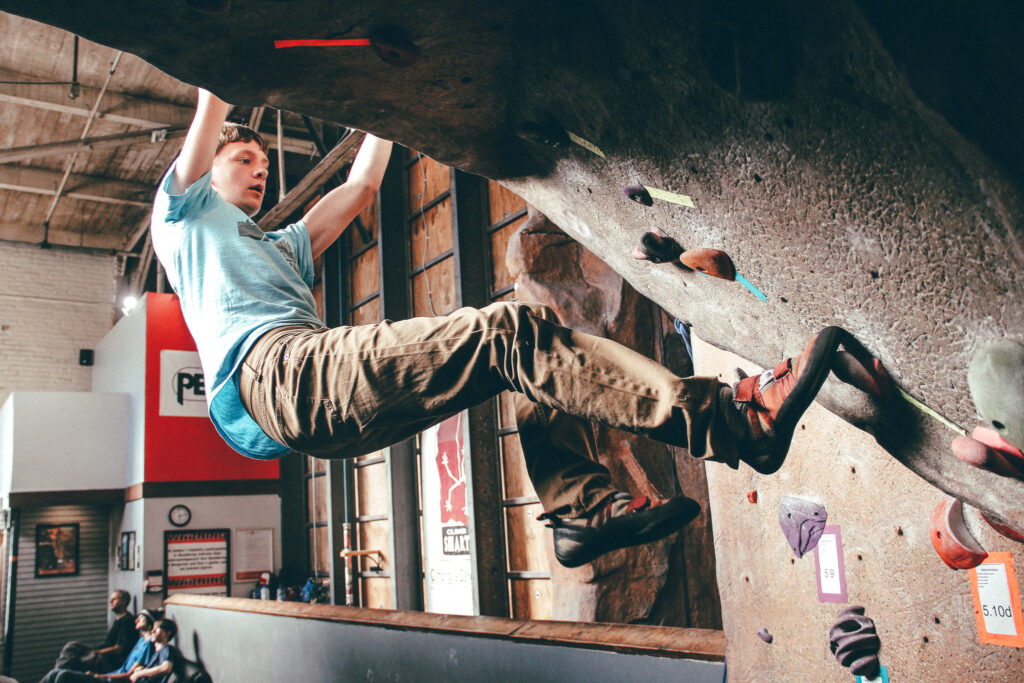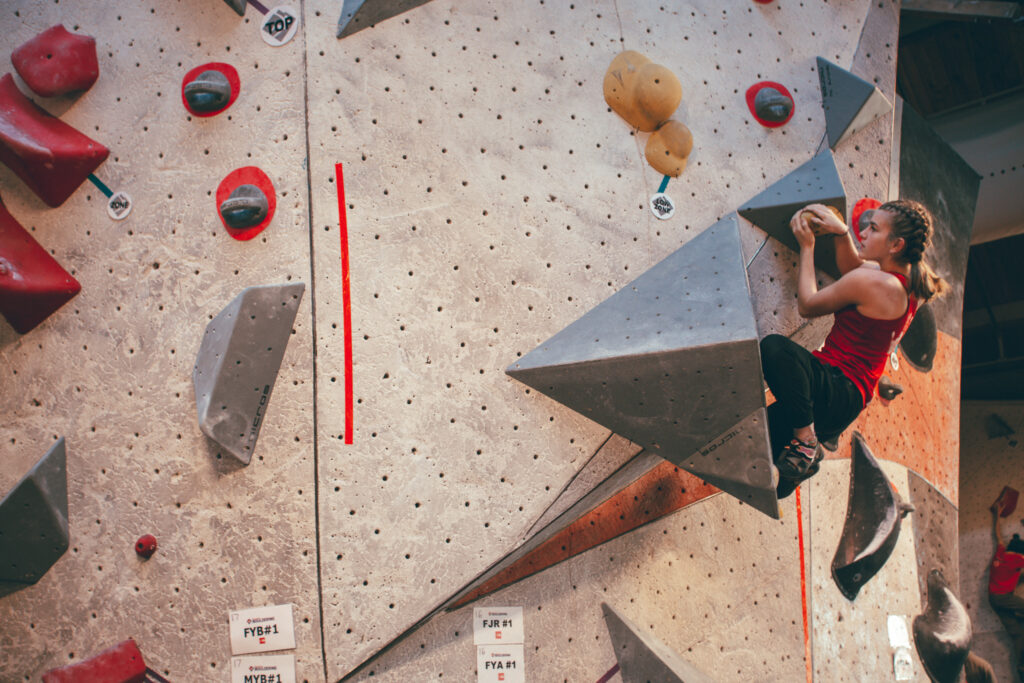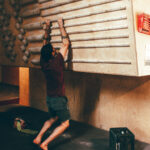The Return of Climbing Terminology
In our never ending quest to educate the masses to sound like a climber, we return to our growing list of climbing terms and definitions. Previous blog articles (here and here) have explained a few of the basic words and phrases that are part of this exciting sport. Climbers have their own unique language and understanding their vocabulary helps you acclimate to the climbing community.
Here are a few more words that will have you speaking like a regular “Old Timer Climber” (OTC):
1. Overhang
A climb, wall, or section of a climbing route that hangs out and over the bottom of the wall. It is a rock face or wall that extends at an angle greater than vertical or more than straight up and down. Improving grip strength and movement technique helps climbers conquer overhanging routes.

2. Roof
An overhang or section of a climb that has gone nearly 90 degrees or more. Particularly steep overhangs that nearly or completely reach horizontal, are called a roof. This is like climbing on the ceiling!
3. Slab
The wall or rock face slopes at a less than 90 degree angle. It is like a steep ramp and is opposite of an overhang. The route is at an angle that is less steep than vertical. Successful slab climbing is often dependent on trusting friction, precise footwork, good body position, putting bodyweight over your feet, and balance.
4. Arête
A corner or part of the route where the wall or rock face juts out to a sharp vertical ridge or point. This is a fancy, French way to refer to the outward-facing corner of a rockface. Difficult arête routes will demand heel hooks, toe-scums, and slap moves because gravity is often pulling you down and away from the wall. It is like trying to scale the corner of the outside of a building.
5. Dihedral
The opposite of an arête. A dihedral is where two planes of a rock wall intersect in an “open book” or inside corner. A climber can use counter-pressure, using hands and feet on opposite sides of the corner pushing outward, and friction to climb it.
6. Project
A particular route or problem that a climber is working to complete . . . some day! A project is a route or climb that a climber is dedicating time to work on—generally at or just above their ability level. While not terribly specific to climbing, it is a term you will hear a lot. It is often used as a verb, as in “I have a route that I’m projecting.”
7. Send
To complete a climb. Sending a route is the most common use of the term. You can also use it in past tense . . . “I sent that route yesterday!” This means successfully reaching the top and finishing a climb without falling or placing your weight on the rope. If someone yells at you while you are climbing, “JUST SEND IT!”, they are most likely encouraging you not to give up and keep at it. If you have been frozen in the same position for the last 5 minutes, scared to make the next move, being told to “send it” likely means, “Quit being a wimp, hurry up, and go for it already!” Either way, it is a good term to know.
8. Crush
This means to completely dominate a climb. To say, “I crushed that route,” means that you practically “flew up” the route with no problems.

9. Sandbag
A climb or route that is deceptively more difficult than its advertised grade. In other words, if a 5.10 route (or V1 bouldering problem) generally climbs like a hard 5.11 (or V3 problem) for most people, then whoever rated the route “sandbagged” it. The grade contradicts how difficult it feels to climb. It is as if you were climbing with a bag of sand attached to your harness.
10. Campus
To climb using only your arms with no feet on the wall. For those who choose to forgo the evolutionary miracle of feet and climb utilizing only handgrip and arm strength. It is also a method of training grip and upper body strength by doing pull-ups as you ascend a “campus board.”
11. Dyno
A dynamic climbing movement is an explosion of momentum to send your body in the direction of the next handhold. In other words, jumping for a hold. A true dyno requires that both hands and/or feet simultaneously disconnect from or leave the wall on their way to grabbing the next hold or holds. It is more of a “leap of faith” and once you “go for it,” then you are committed to the move. . . there’s no going back!
12. Static
Using your muscles, as opposed to momentum, to move from one hold or set of holds to another. Completing a climbing move smoothly, without utilizing a dyno or dynamic movement. Static climbing is a slower, more controlled movement. Dynamic movement is more short bursts of powerful moves.
13. Whipper
A whipper is a big fall. It is called this because when a lead climber falls from above their last piece of protection, they will plummet in an arcing manner and the slake in the rope will create a whip-like motion. If a climber take a longer than usual fall, they might hear another climber exclaim, “That was quite a whipper!” Taking a whipper in an indoor setting is dangerous and discouraged due to the increased risk of ground fall on shorter routes and injury to the climber, the belayer, or those nearby. Whippers are also rough on the rope, anchors, and gear.
14. Pumped
Muscle pump, where blood engorges muscles due to intense effort – mainly forearms for climbers. Contrary to what you might think, getting pumped does not mean that you are excited! Far from it, getting pumped describes the sensation of extreme fatigue you get in your forearms. When you are over gripping and hanging on with everything you have for an extended period of time, lactic acid begins to accumulate in your muscles as they fatigue, making them feel inflated, tight, and clumsy, hence the name. When your forearms are so pumped that they feel absolutely useless, you are “pumped out!”
15. Smear
When there is a lack of footholds, using the friction of shoe rubber on the bare rock or textured wall is called “smearing.” The more pressure you put on your smearing foot and the more surface area you can contact, the more friction there is to help it stick. You are taking advantage of sticky (soft) rubber climbing shoes to stick your foot on the wall where there’s no hold, and “smearing” against it using the friction to keep from slipping. This is a good intermediate technique to keep contact with the wall surface providing enough traction to get to the next foothold.
Next time you are climbing, use a few of these terms and others will soon be asking you to spray some beta!
Climbing is dangerous, it involves inherent and other risks and cannot be eliminated. The information presented here does not describe all of the risks associated with climbing and is not intended to replace or supersede expert instruction and training.
© 2023 Vertical Endeavors, Inc. All rights reserved. The contents of this article, photographs, and graphical representations are protected by U.S. and International copyright laws. Reproduction and distribution, in part or whole, without written permission from Vertical Endeavors are prohibited.

